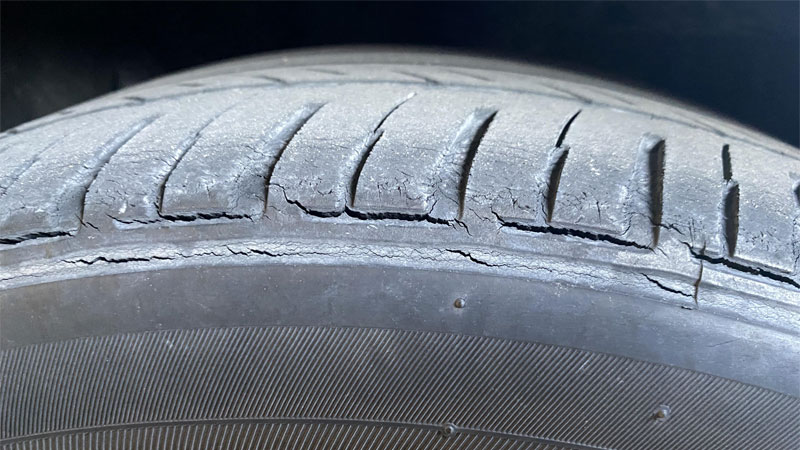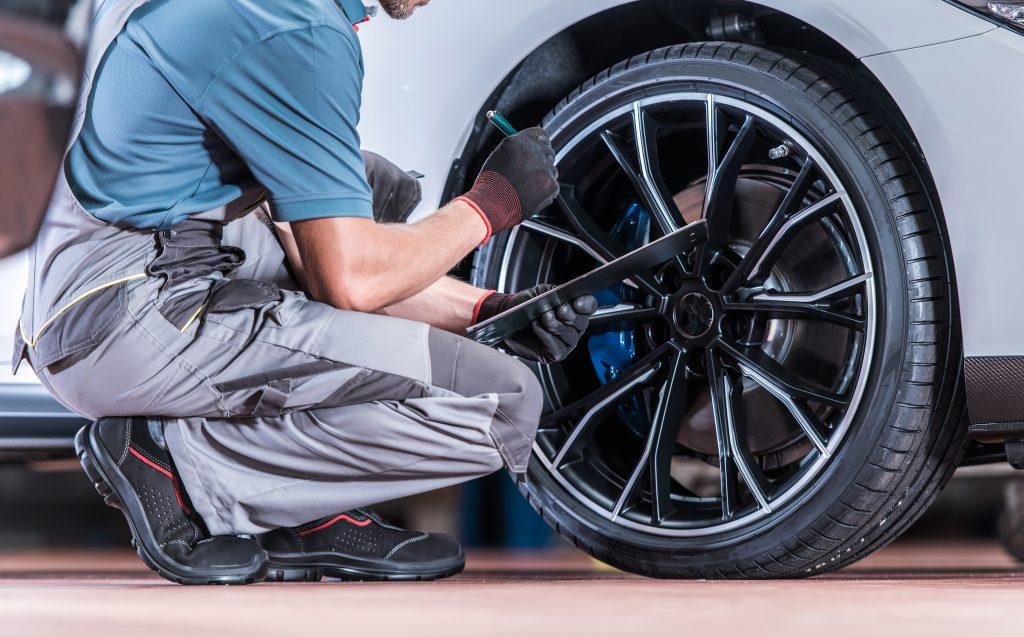To repair a tire, follow these steps: locate the puncture, remove the offending object, insert a tire plug, and re-inflate the tire. Knowing how to repair a tire can save you time and money, and help you avoid being stranded on the side of the road.
Whether you’re dealing with a slow leak or a blowout, being able to fix the problem quickly and safely will get you back on the road with minimal disruption. In this article, we’ll take a look at the steps involved in repairing a tire so that you can handle this common automotive issue with confidence.
From finding the puncture to sealing it up and re-inflating the tire, we’ll cover all the details you need to know to get the job done right.

Credit: autotrends.org
Identifying The Problem
Signs Of A Punctured Or Damaged Tire
Before we can repair a tire, we must first identify the problem.
- Flat tires
- Low tire pressure
- Tread wear or damage
- Bulges or blisters on the tire
- Sidewall damage
If you’ve experienced any of these issues, it’s time to check your tires for further damage.
Understanding The Extent Of Damage
Once you’ve identified the problem, you need to understand the extent of the damage.
- Holes or punctures in the tire tread
- Cuts or slices in the tire
- Damage to the rim of the wheel
- Additional damage to the tire, such as to the sidewalls or inner liner
It’s important to note that not all damage can be repaired. For example, if a tire has a puncture larger than 1/4 inch in diameter, the tire cannot be repaired safely.
How Tire Repair Is Affected By Location Of Damage
The location of the damage is a crucial factor when determining if a tire can be repaired. Repairs can only be made to the center of the tire’s tread area.
- Outside of the tire’s main tread area
- In the sidewall of the tire
- In the shoulder or belt areas of the tire
If the damage is not in the correct area of the tire, it cannot be repaired.
By following these guidelines, you can identify the problem and extent of damage to your tire, and determine if the tire can be safely repaired. Remember, safety should always be your top priority when repairing tires.
Tools Needed For Tire Repair
Essential Tools For Tire Repair
Repairing a flat tire is a task that all vehicle owners should know how to do. While it may seem like a daunting task, having the right tools at your disposal can make the process much smoother.
- Tire plug kit: This kit contains a reamer, insertion tool, and plugs, which are necessary for puncture repairs.
- Tire pressure gauge: This tool ensures that your tire pressure is at the correct level.
- Valve core tool: This tool is used to remove and install valve cores when repairing or inflating tires.
- Pliers: You’ll need pliers to remove any sharp objects that may be lodged in your tire.
- Tire irons: These tools are necessary for removing the tire from the rim, and for removing and replacing the valve stem.
Importance Of Having The Right Tools
Using the right tools is imperative for repairing a tire effectively. Without the proper tools, you may not be able to repair the tire correctly or efficiently. This can lead to more problems down the line, and possibly even a tire blowout.
Investing in the right tools not only makes repairing a tire easier, but it can also save you time and money in the long run.
Tips On Obtaining The Necessary Tools
When looking to purchase the necessary tools to repair a tire, always opt for high-quality options. While they may be a bit more expensive, they are more likely to last longer and provide better results. It is also essential to make sure that the tools you are purchasing are appropriate for the type of tire you have.
Before investing in new tools, check with your local mechanic or tire shop to see if they offer tire repair services. If so, they may be able to lend or rent you the necessary tools. Additionally, you can opt to purchase a tire repair kit that will contain all the necessary tools.
Remember, having the right tools is key to repairing a tire correctly and efficiently. With these essential tools in hand, you can have peace of mind knowing that you can handle a flat tire with ease.
The Repair Process
Repairing a flat tire is an essential skill every driver should have, especially if there’s no auto service station nearby. Instead of waiting for help, you can simply learn the repair process and fix your tire. In this guide, we’ll cover the step-by-step instructions to repair a tire, safety protocols to follow, and the possible pitfalls to avoid during the repair process.
Step-By-Step Instructions For Repairing A Tire
- Start by locating the puncture in your tire.
- Remove the wheel and deflate the tire completely.
- Use a tire probe to determine the size of the hole and clean the area around it.
- Insert the t-shaped plug into the hole and make sure it covers the entire puncture.
- Pull the plug insertion tool out slowly, making sure the plug is in place.
- Trim the excess plug material using scissors or a sharp blade and inflate the tire.
- Finally, check the repaired area to ensure there’s no air leakage.
Safety Protocols That Must Be Followed
- Always work on a level surface and use wheel chocks to prevent the vehicle from rolling.
- Put on gloves and glasses before handling tire repair tools.
- Make sure the tire is completely deflated before attempting to remove it.
- Never attempt to repair a tire that has more than one puncture.
- Use only high-quality plug repair kits and follow the manufacturer’s instructions.
Possible Pitfalls To Avoid During The Repair Process
- Over-inflating the tire after the repair can cause the plug to loosen or the tire to burst.
- Failing to remove foreign objects, such as nails or screws, from inside the puncture can cause further damage to the tire.
- Placing the plug too deep into the tire can cause the plug to come out or not seal correctly.
- Attempting to repair sidewall punctures is not recommended and should be replaced instead.
Now that you know how to repair a tire, you’ll be able to handle roadside emergencies with ease. Remember to follow the safety protocols and avoid the possible pitfalls to ensure a successful repair.
Post-Repair Tips
How To Check If The Tire Is Properly Repaired
If you have repaired your tire, it is essential to ensure that it is completely safe before driving on it.
- Check the sealant: Make sure the sealant covers the puncture hole completely and neatly. If there are any gaps, the tire needs further repair.
- Check the air pressure: Ensure that the tire has the proper air pressure. A tire with incorrect pressure could lead to road accidents. Refer to the car manual for the right pressure requirement.
- Check for vibrations: While driving on the road, if you feel any unusual vibrations or wobbling from the tire, it could be a sign of an incomplete or incorrect repair.
- Take it to a professional: It’s best to ask a professional’s opinion before taking your car out. They have the necessary tools and technology to ensure the tire is fully repaired and safe to drive.
Precautions To Take After Repairing A Tire
After repairing a tire, there are certain precautions to consider to keep it in good condition.
- Avoid overloading: Heavy loads can cause wear and tear to the tire tread, leading to damage or punctures in the future.
- Check the tire pressure regularly: Maintaining the correct tire pressure not only ensures a safe drive but also increases the longevity of tires. Check the pressure at least once a month.
- Avoid potholes and rough terrain: Driving over rough roads or potholes can lead to tire damage. Avoid such roads if possible, and be sure to drive at a moderate speed on rough terrain.
- Avoid sudden braking: Sudden stops can cause the tire to skid and wear out quickly. Drive at a steady pace and brake slowly when necessary.
Tips On Maintaining Tire Health
Tires are crucial for vehicle safety, and proper maintenance ensures longevity and safe driving.
- Rotate the tires: Rotation helps to distribute the wear and tear evenly, increasing the lifespan of the tire.
- Check the tread depth: Inspect the tire for worn-out tread. The minimum tread depth should be at least 1. 6mm, as per legal requirements.
- Check tire alignment: Poor alignment can lead to uneven wear and tear, affecting the overall performance of your vehicle. Get your car’s alignment checked every six months.
- Keep the tires clean: Dirt and debris accumulation can reduce tire life. Keep the tires clean and free of debris.
With these simple steps, you can maintain the condition of your tire post-repair and ensure safe driving.
Frequently Asked Questions Of How To Repair A Tire
How Do I Know If My Tire Needs Repair?
If you notice unusual bulges, cracks, or punctures in your tire, it may need repair. Also, if your tire pressure keeps dropping, it may have a slow leak.
Can I Repair A Tire Myself?
Yes, you can repair most small punctures or leaks in your tire by yourself. Just make sure to have the right tools, a tire repair kit, and follow all safety precautions.
Is It Safe To Drive On A Repaired Tire?
Yes, it is safe to drive on a properly repaired tire; however, it is recommended to avoid high speeds and long distances. It’s best to get the tire checked by a professional as soon as possible.
How Much Does It Cost To Repair A Tire?
The cost to repair a tire can vary depending on the extent of the damage and the type of tire. On average, tire repair costs between $20 to $40, but it could be more if a new tire is needed.
Can All Tires Be Repaired?
No, not all tires can be repaired. The tire industry association provides guidelines for repairable tires, but some factors such as the location and size of damage may also play a role. It’s best to consult a professional to determine if your tire is repairable.
Conclusion
After reading this comprehensive guide on how to repair a tire, you are now equipped to deal with the most common issues faced by motorists. Remember to take all necessary precautions when attempting to fix a punctured or flat tire, and always carry a repair kit with you when possible.
By following the step-by-step instructions outlined in this post, you will be able to patch the tire yourself and avoid costly repairs at a mechanic. It is essential to inspect your tires regularly to prevent punctures and ensure proper inflation.
In case of faulty or damaged tires, replacement is always the safest option. We hope you found this article informative and learned how to repair a tire like a pro.

